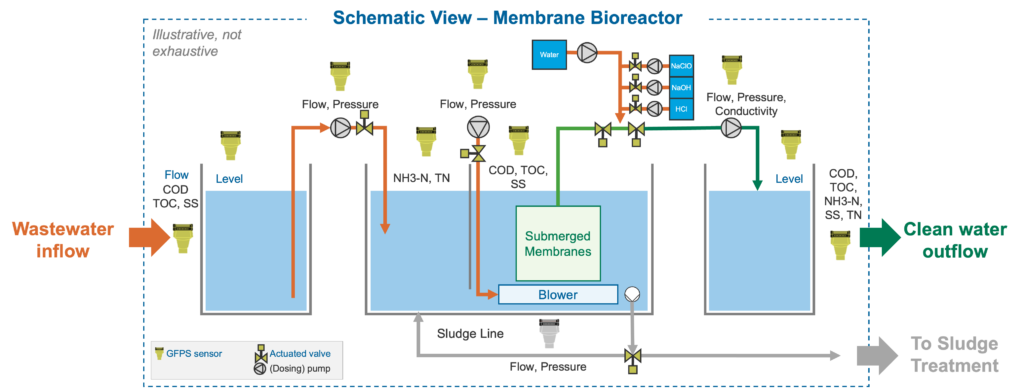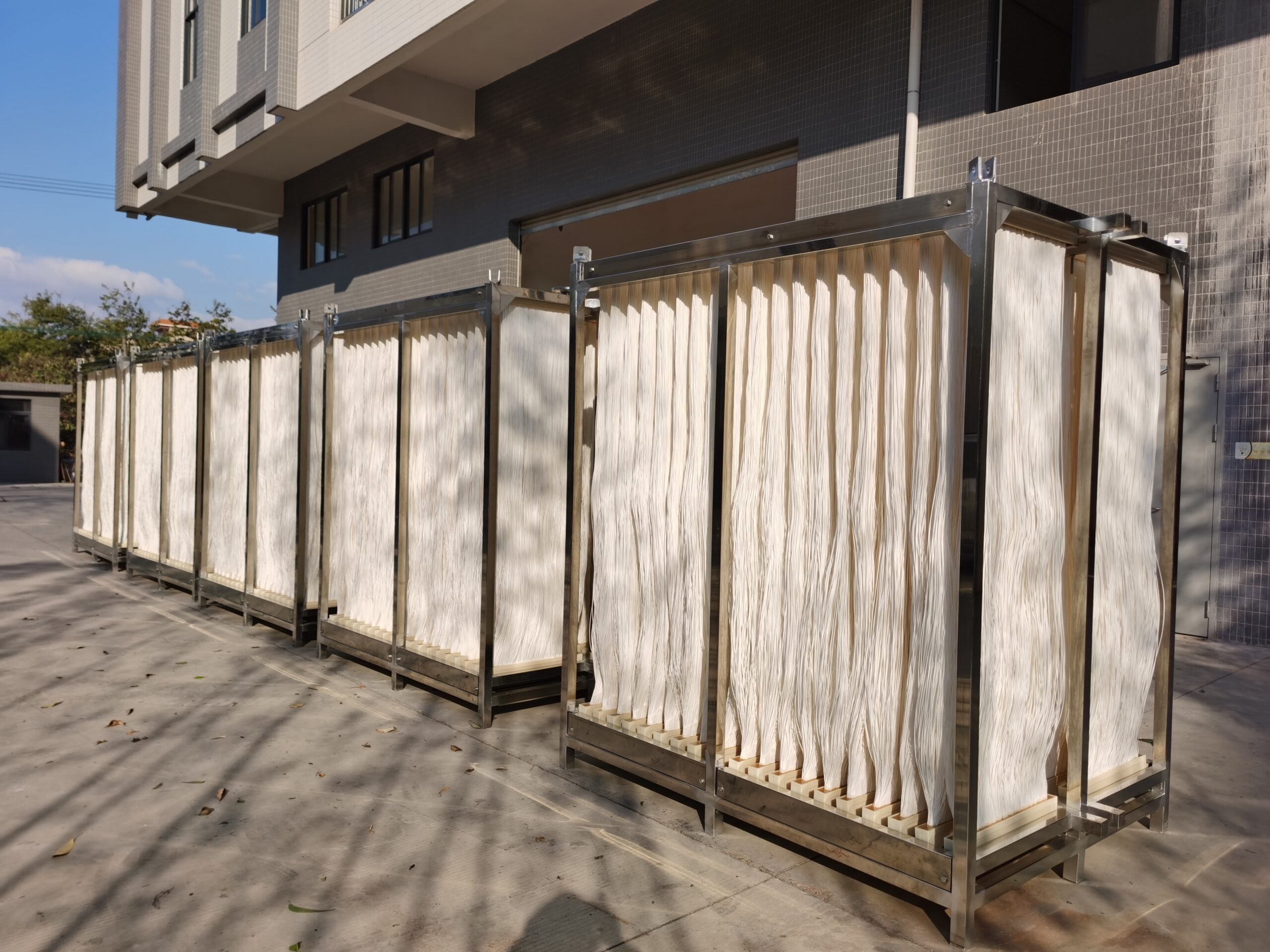Exactly How Membrane Bioreactors Are Revolutionizing Water Purification Systems
The introduction of membrane layer bioreactors (MBRs) represents a substantial innovation in the field of water filtration, combining biological treatment processes with sophisticated membrane layer filtering modern technologies. This assimilation not only enhances the quality of dealt with effluent but additionally addresses city space constraints, making MBRs particularly appropriate for densely booming locations. As global water shortage increases, the duty of MBRs in promoting potable water reuse and lasting water administration becomes significantly vital. Yet, the implications of this innovation prolong beyond effectiveness-- what difficulties and opportunities lie in advance for its extensive execution?
Summary of Membrane Layer Bioreactors
Membrane layer bioreactors (MBRs) represent a significant improvement in water purification modern technology, as they incorporate biological treatment processes with membrane filtering. This integration improves the performance of wastewater treatment by using bacteria to degrade natural contaminants while concurrently employing semi-permeable membranes to different cured water from suspended pathogens and solids.
The MBR system typically contains a biological reactor where the microbial population metabolizes contaminants, followed by a membrane layer filtration unit that retains biomass and allows just tidy water to go through. This dual capability leads to greater effluent top quality compared to conventional therapy techniques. MBRs can be run in both batch and continual circulation modes, providing versatility in layout and application.
In Addition, MBRs are defined by their small footprint, making them ideal for city setups with area restrictions. Membrane Bioreactor. They likewise allow the recovery of water for reuse, thus contributing to water sustainability initiatives. While MBR innovation has acquired appeal in industrial and community applications, its operational complexities and energy needs demand cautious factor to consider throughout execution. On the whole, MBRs are at the leading edge of enhancing water therapy performance and high quality, showcasing the possibility for cutting-edge solutions in environmental monitoring.
Benefits of MBR Modern Technology
The assimilation of organic therapy with membrane layer filtration supplies many advantages for water purification procedures. Among the primary advantages of Membrane Bioreactor (MBR) innovation is its capacity to efficiently remove both natural and not natural pollutants, leading to premium effluent. The membranes act as a physical barrier, stopping suspended solids and microorganisms from travelling through, which enhances the overall security and integrity of treated water.
Furthermore, MBR systems need a smaller impact compared to standard therapy approaches, permitting a lot more reliable room application. This compact design is especially advantageous in urban settings where land is restricted. MBRs additionally demonstrate functional flexibility, suiting varying influent top qualities and flow rates without considerable performance degradation.
Furthermore, the process offers boosted nutrient elimination capabilities, particularly for nitrogen and phosphorus, which are critical for avoiding eutrophication in getting waters. The minimized sludge manufacturing linked with MBR innovation likewise translates to lower disposal prices, making it an economical option over time - Membrane Bioreactor. On the whole, the advantages of MBR modern technology placement it as a leading selection for sustainable and cutting-edge water purification systems, resolving both environmental and economic concerns
Applications in Water Purification
Applications of Membrane Bioreactor (MBR) technology in water filtration are impactful and diverse, addressing different treatment requires throughout multiple fields. MBRs efficiently integrate biological therapy processes with membrane layer filtering, making them suitable for municipal wastewater treatment, industrial effluent management, and even drinkable water reuse campaigns.
In local settings, MBRs are progressively employed to improve the quality of dealt with wastewater, allowing for compliance with strict discharge guidelines and promoting the recycling of water for watering and non-potable usages. Their portable style also makes them suitable for city settings where area is limited.
Industrially, MBR innovation is made use of to treat procedure water and wastewater, especially in sectors such as food and drink, pharmaceuticals, and fabrics. By effectively getting rid of contaminants and suspended solids, MBRs assist markets decrease ecological influences while recouping useful resources from wastewater streams.
In Addition, MBRs are gaining traction in decentralized water therapy applications, where small-scale systems can be deployed in remote areas or establishing areas. This versatility makes it possible for neighborhoods to attain sustainable water monitoring services, boosting access to clean water while lowering reliance on typical treatment methods.
Case Studies and Success Stories

In one more example, a fabric manufacturing facility in Bangladesh adopted MBR technology to resolve its wastewater difficulties. The system minimized chemical oxygen demand (COD) degrees from 1,200 mg/L to much less than 100 mg/L, thus satisfying governing standards and considerably decreasing environmental influence.
The University of Cape Community's MBR installment has actually verified effective in dealing with greywater for non-potable reuse on university. This job not just preserves safe and clean water yet additionally acts as an educational version for sustainable techniques.
Moreover, a seafood handling plant in Norway used MBR modern technology to treat effluents having high levels of raw material, attaining over 90% pollutant removal. These study highlight MBR modern technology's convenience and its vital role in boosting water quality throughout varied applications.
Future of Water Treatment Solutions
As global water deficiency and air pollution challenges heighten, ingenious water therapy solutions are ending up being significantly vital to make certain lasting accessibility to tidy water. The future of water therapy hinges on the right here integration of advanced technologies that enhance the effectiveness and effectiveness of purification processes. Membrane bioreactors (MBRs) go to the forefront of this evolution, integrating organic therapy with membrane layer filtering to create high-quality effluent suitable for various applications.

Emerging patterns such as source recovery from wastewater, consisting of nutrients and energy, will better transform treatment facilities right into environmentally friendly hubs. Innovations in nanotechnology and membrane layer materials assure enhanced performance and long life of filtration systems.

Conclusion
In conclusion, membrane layer bioreactors represent a considerable improvement in water filtration innovations, successfully combining organic treatment with innovative membrane filtration. The countless benefits, consisting of improved effluent high quality and reduced spatial needs, make MBRs specifically appropriate for city applications. Their function in drinkable water reuse and sustainable water administration highlights their importance in attending to international water deficiency challenges. Continued r & d will further improve the effectiveness and fostering of MBR modern technology, making sure a resilient future for water treatment services.
The introduction of membrane layer bioreactors (MBRs) stands for a significant development in the area of go water filtration, combining biological therapy procedures with advanced membrane filtration innovations. As worldwide water deficiency intensifies, the role of MBRs in promoting potable water reuse and lasting water management comes to be increasingly important. They also allow the recuperation of water for reuse, thus contributing to water sustainability campaigns.As global water deficiency and contamination obstacles intensify, ingenious water therapy remedies are becoming significantly vital to guarantee lasting accessibility to tidy water. Their duty in potable water reuse and sustainable water administration highlights their relevance in addressing global water scarcity challenges.